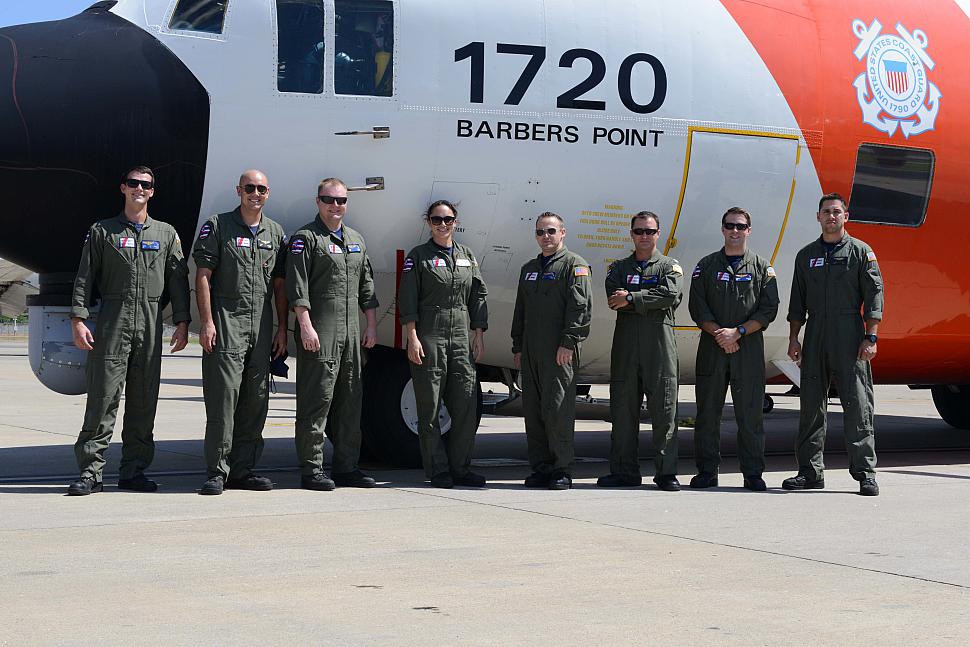C-130 News
C-130 Hercules News
USCG aircrew returns home following Eastern Pacific deployment
March 11, 2016 (by
PO3 Melissa McKenzie) -
An HC-130 Hercules aircrew returned to Coast Guard Air Station Barbers Point, Oahu, in late January after a two-week Joint Inter-agency Task Force South counter-narcotics patrol in the Eastern Pacific.

During deployment the aircrew monitored and detected the movement of narcotics from drug smuggling vessels into the U.S. resulting in the interdiction of 1,872 pounds of cocaine with an estimated street value of $28.2 million.
The aircrew flew 60 hours and more than 7,250 miles in support of the counter-narcotics mission.
“The hard work and commitment demonstrated by this aircrew to support the Coast Guard’s missions was remarkable,” said Cmdr. Jeffrey Jager, operations officer at Air Station Barbers Point. “As a result, we disrupted transnational organized crime networks and kept illegal drugs from reaching the United States and partner nations.”
Aircrews routinely conduct operations from South America to the Bering Sea conducting alien migrant interdiction operations, domestic fisheries protection, search and rescue, counter-narcotics and other Coast Guard missions at great distances from shore keeping threats far from the U.S. mainland. In fiscal year 2015, which runs Oct. 1, 2014, to Sept. 30, 2015, ASBP aircrews flew four counter-narcotics deployments resulting in four disruptions and one interdiction.
U.S. military, law enforcement agencies and regional partner-nation law enforcement agencies patrol the waters in the Caribbean Sea, Gulf of Mexico and the Eastern Pacific on a year-round basis in an effort to detect, monitor and interdict illicit traffickers.
“Illicit trafficking networks threaten the stability of Latin America and the Caribbean, U.S. public health and our national security,” said Vice Adm. Charles Ray, commander, Coast Guard Pacific Area. “Well-resourced organized crime groups move drugs, weapons, counterfeit items, money and people through these networks. This insidious web of crime threatens citizen security, undermines basic human rights, cripples the rule of law through corruption, erodes good governance and hinders economic development. The U.S. Coast Guard works with federal agencies and international partners in the region to counter these threats.”
The Coast Guard removed over 319,185 pounds of cocaine and 78,262 pounds of marijuana in fiscal year 2015 with an estimated value of $4.4 billion. Approximately 75 percent of the cocaine was removed from the Eastern Pacific Ocean near Central and South America.
The Coast Guard’s leadership role in Western Hemisphere security and prosperity is critical in the fight against transnational organized crime networks active in region as continually strained national security resources are stretched across the globe.

An USCG aircrew stationed at Air Station Barbers Point stand with HC-130H #1720 for a photo the final day of their 14-day deployment in Central America on January. 26, 2016. Military patrol aircraft conduct around-the-clock patrols in the Eastern Pacific in the hopes of curving illegal drug trafficking in the region. [USCG photo by PO2 Melissa E. McKenzie]
The aircrew flew 60 hours and more than 7,250 miles in support of the counter-narcotics mission.
“The hard work and commitment demonstrated by this aircrew to support the Coast Guard’s missions was remarkable,” said Cmdr. Jeffrey Jager, operations officer at Air Station Barbers Point. “As a result, we disrupted transnational organized crime networks and kept illegal drugs from reaching the United States and partner nations.”
Aircrews routinely conduct operations from South America to the Bering Sea conducting alien migrant interdiction operations, domestic fisheries protection, search and rescue, counter-narcotics and other Coast Guard missions at great distances from shore keeping threats far from the U.S. mainland. In fiscal year 2015, which runs Oct. 1, 2014, to Sept. 30, 2015, ASBP aircrews flew four counter-narcotics deployments resulting in four disruptions and one interdiction.
U.S. military, law enforcement agencies and regional partner-nation law enforcement agencies patrol the waters in the Caribbean Sea, Gulf of Mexico and the Eastern Pacific on a year-round basis in an effort to detect, monitor and interdict illicit traffickers.
“Illicit trafficking networks threaten the stability of Latin America and the Caribbean, U.S. public health and our national security,” said Vice Adm. Charles Ray, commander, Coast Guard Pacific Area. “Well-resourced organized crime groups move drugs, weapons, counterfeit items, money and people through these networks. This insidious web of crime threatens citizen security, undermines basic human rights, cripples the rule of law through corruption, erodes good governance and hinders economic development. The U.S. Coast Guard works with federal agencies and international partners in the region to counter these threats.”
The Coast Guard removed over 319,185 pounds of cocaine and 78,262 pounds of marijuana in fiscal year 2015 with an estimated value of $4.4 billion. Approximately 75 percent of the cocaine was removed from the Eastern Pacific Ocean near Central and South America.
The Coast Guard’s leadership role in Western Hemisphere security and prosperity is critical in the fight against transnational organized crime networks active in region as continually strained national security resources are stretched across the globe.
Courtesy of U.S. Coast Guard District 14 Hawaii
Related articles:
Forum discussion:
Tags
Forum discussion:
- Start a discussion about this article in the C-130.net forum.
Tags
